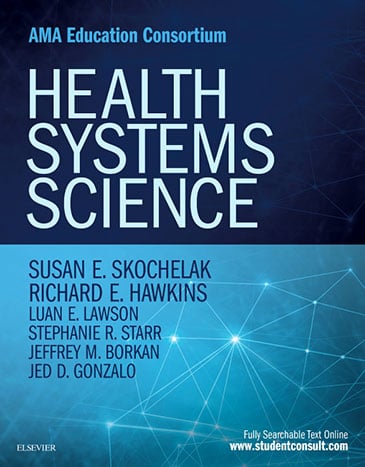As the U.S. health care system moves toward value-based care, medical schools must adapt their curricula to ensure students acquire not only basic and clinical scientific knowledge but also an understanding of how patients access and receive health care. A new textbook is the first of its kind to define and codify this third pillar of medical education and provide a framework for its implementation nationwide.
Health Systems Science, parts of which are already in use in medical schools across the country, was coauthored by experts from the AMA and faculty from 11 of the 32 member schools in its Accelerating Change in Medical Education Consortium.
The textbook grew out of a need to define the topics within health systems science from the perspective of those who deliver care to patients. There are other books on health systems topics but they are primarily intended for administrators or managers.
“We know that the way health care is being delivered is changing, but until now those changes have not been widely incorporated into the way we teach our physicians,” said AMA CEO James L. Madara, MD. “Our medical schools are very good at preparing students for the basic and clinical sciences that are paramount to providing care to patients, but what is largely missing is how to deliver that care in a complex health system.”
Ready for integration into curricula
Whereas knowledge of basic science is crucial for understanding the working of the human body and clinical experience is essential for knowing which prevention strategy or treatment a patient needs, health systems science teaches physicians how to best apply their medical education in the context of health care delivery.
The textbook’s table of contents can be used as the framework for integrating health systems science into current coursework. Topics include:
- Patient safety
- Quality improvement
- Teamwork and team science
- Leadership
- Clinical informatics
- Population health
- Socio-ecological determinants of health
- Health care policy and economics
Its content is intended to be relevant to all learners within the health professions.
Health Systems Science is already in use at Penn State College of Medicine and the Warren Alpert Medical School of Brown University.
With a $1 million grant from the AMA, Penn State launched its Systems Navigation Curriculum in 2014. The program embeds first-year medical students as patient navigators in outpatient and inpatient clinical sites throughout central Pennsylvania. That is an important innovation in medical education because most medical students are trained largely in hospital settings even though the majority of patient encounters happen in physician offices.
Brown, which also received a $1 million AMA grant to support its curriculum transformation, created its Primary Care-Population Medicine program in 2015. This first-in-the-nation program, which awards graduates both a Doctor of Medicine and a Master of Science in Population Medicine, is designed to develop physicians who, with training focused on population and public health, can be future leaders in community-based primary care.
Health Systems Science will be available to all medical schools in mid-December. The authors hope it will serve as a starting point for consortium schools to build additional health systems science tools.
Part of larger change-making effort
“Our goal is to enable all medical schools across the country, not just those working with the AMA’s consortium, to access this innovative work and the consortium’s expertise to make sure their students become physicians who understand how patients receive and access care in today’s health care systems,” said AMA Vice President for Medical Education Outcomes Susan E. Skochelak, MD. Dr. Skochelak also is one of the textbook’s editors and an author of two of the chapters.
The AMA launched its Accelerating Change in Medical Education initiative in 2013, providing $11 million in grants to fund major innovations at 11 of the nation’s medical schools. Together, these schools formed a consortium to share best practices with a goal of widely disseminating the newly developed curricula.
The AMA expanded the consortium in 2015 with grants to an additional 21 schools to develop teaching strategies that better align undergraduate medical education with the modern health care system.
“By working together with our consortium schools,” Dr. Madara said, “we are taking the right steps to prepare tomorrow’s physicians to be equipped to quickly adapt to the changing health care landscape and provide value-based care as soon as they enter practice.”
Available for preorder
Health Systems Science, published by Elsevier, can be preordered from the AMA Store and Elsevier, as well as from Amazon and other online booksellers. The textbook retails for $59.99. AMA members may order it from the AMA Store for $54.99. Individual chapters will also be available from Elsevier for $5.99 each.




